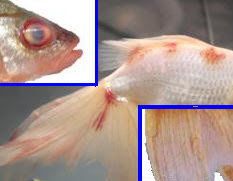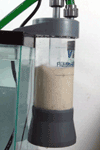Copyright; Carl Strohmeyer
Updated 3/16/23
 Once again, the forum Aquatic Community is back to "cutting & pasting" information.
Once again, the forum Aquatic Community is back to "cutting & pasting" information.
As with their totally intellectually dishonest attack on Wonder Shells and a well researched chemistry article (Wonder Shells, Forum Hall of Shame), they make statements with little basis in science.
In this article, their information is almost word for word the same as a few other anecdotal articles about "Red Pest", hence the comment of "cutting & pasting" information.
Sadly many poor search engines have picked this up as if re-posting the same bad information suddenly makes it true, but it does not and the facts are still the same: "Red Pest" IS NOT A FISH DISEASE!!
ADVERTISEMENT:
What is "Red Pest"?
All these people are doing is making up a new name for Septicemia. As well technically speaking, when referring to fish, Septicemia is NOT a disease either, rather a symptom of other pathogens or a or the results of water conditions (usually both)!!
Reference from:
http://www.merriam-webster.com/dictionary/septicemia
-invasion of the bloodstream by virulent microorganisms and especially bacteria along with their toxins.
While the reference is a human description of Septicemia (what these people so cutely call Red Pest), it still applies to fish as medical terminology. Medical terminology regardless whether it's for fish or humans is medical terminology.
Where fish and humans may part ways is the pathogen or pathogens which cause the Septicemia.
Fish and humans are susceptible to different pathogens. It is these different pathogens that must be treated and defeated, NOT the symptoms!!
By far the most common cause in fish is the Aeromonas or Marine Vibrio bacteria, which is a gram negative, aerobic or anaerobic bacterium.
This is often trigged by poor water conditions with high amounts of decomposing organic debris/mulm in substrate (or poor or poorly maintained filters).
High nitrates and a poor Redox are common when the "condition" of Septicemia is present
However this poisoning of the blood can be caused by a virus; known as "Viral hemorrhagic septicemia virus" (VHSV, or VHSv). Even more rare cases internal nematode worm infections can release poisons into the bloodstream also causing Septicemia.
Generally VHSV is limited to freshwater salmonids in western Europe, not tropical aquarium fish or goldfish.
What is the importance of a correct diagnosis? Instead of acting like "Red Pest" is a true fish disease?
For starters, Aeromonas is a disease of opportunity. To treat just one symptom would allow the possibility for this disease to rebound, assuming it is even eliminated in the first place. Incorrect medications and incomplete treatment are recommended by these articles about "Red Pest".
Often water conditions are poor where an Aeromonas infection is present. This could be copious amounts of waste, over loaded or poor filters, or the pH, KH, GH, & Redox (& rH) are all too low or unstable.
Rotting fish food or poor digestibility of fish food can allow for a gut infection of Aeromonas.
Sometimes with Mollies just correctly mineralizing your water with products such as American Aquarium Wonder Shells is all that is needed for a so-called cure. WHY? Because this was NOT a disease, rather symptom of poor water quality resulting in septicemia.
Product Resource: Unique Wonder Shells found ONLY at American Aquarium
So, to not address these possibilities or more than likely probabilities, would be an incomplete treatment at best. Sort of like treating your brain tumor with an aspirin! It helps with the pain, but does not cure the tumor.
What happens with Septicemia (Red Pest)?
Often Aeromonas can go internal in a fish, such as the gut or other internal locations. As well, this bacterium can be an external infection which simply gets into the bloodstream and then poisons the fish.
What is the best course of action (treatment)?
Since the main purpose of this article is provide correct identification and put an end to the misinformation (as with many "Fish as Pets" articles), I will not go into too much detail other to refer readers to read this article for more in depth information on treatment:
FISH AEROMONAS, SEPTICEMIA
I will however cover a few basics, only to correct the poor information provided elsewhere by those calling this
"Red Pest" disease:
- The obvious is since 9 times out of 10 poor water conditions are a factor, look to improve these.
Check, clean, change substrate & filters. Make sure water conditions are where they should be, INCLUDING Redox (which is often simply improved by improving other parameters along with the addition of mineral Cations and true UVC sterilization)
Reference: Aquarium Redox
Resources:
*AAP Unique Wonder Shells for Redox improving Mineral Cations
*AAP/TMC Vecton UV Sterilizers - One point they do get right is a fish food medication soak, although since Chloramphenical is not available, Kanamycin is the next best choice. This can also be added directly to the water.
Neomycin OR Metronidazole are good choices to combine with the Kanamycin in the fish food, with the Metronidazole being the better choice if the cause is suspected to possibly be a nematode worm, which is not common.
Good sources for these medications are HERE:
SeaChem Kanaplex, SeaChem Metronidazole, & SeaChem Neoplex (Neomycin). - Next, what Aquatic Community and others miss is a fish bath is often the must successful for total eradication.
See FISH BATHS - As well the Aquatic Community article and others, including cut and paste advice on "Yahoo Answers" make incorrect/contradictory medication recommendations.
From their article:
"There are a variety of different antibiotics that can be used, e.g. tetracycline and chloromycetin (chloramphenicol)".
First chloramphenicol might be a good choice if you could find it (although it has been has been linked to the development of aplastic anemia). However, to make the statement that a variety of different antibiotics that can be used is medically incomplete. There is a reason we have so many antibiotics and to attempt to treat a gram negative infection such as Aeromonas with a gram positive treatment such as Tetracylcine, is simply NOT GOING TO WORK!
WORSE YET, is the the fact Tetracycline lowers red blood cell count; WHY ON EARTH WOULD YOU TREAT AN INFECTION OF THE BLOOD WITH AN ANTIBIOTIC THAT LOWERS RED BLOOD CELL COUNT???
Other in-tank or hospital tank treatments to consider are Triple Sulfa or the very broad spectrum treatment "AAP Spectrogram"
Resources:
AAP Spectrogram; Synergistic blend of Kanamycin/Nitrofurazone
AAP Triple Sulfa
Please Read;
Other considerations include preventative measures such as better bio filtration using premium sponge filters or the best bio filters, Fluidized Sand Bed Filters.
Resources:
As well feeding a highly digestible food such as Spirulina based fish foods can help with prevention of Aeromonas in the gut.
Resources:
Spirulina 20 from American Aquarium
AAP Premium & Paradigm Fish Foods
Finally adding a quality UV Sterilizer such as the AAP/TMC Vecton that can perform true level one sterilization, NOT the junk sold on Amazon, eBay, and elsewhere for under $50 that are AT BEST just clarifiers, NOT true UV Sterilizers.
These level one or two sterilizers can help with water borne infections and also improve Redox Balance, thus improving fish immune response.
Resources:
- Level One Capable UV Sterilizer
- Level One UV Sterilization for Aquarium or Pond; Complete Information
- Redox Balance
The Aquatic Community article in question is found here:
http://www.aquaticcommunity.com/disease/redpest.php
If you are looking to step up in your fish care, to an advanced level, I highly suggest reading these two in-depth researched articles:

UV-C Sterilization, Facts & Information


TMC Premium Fluidized Sand Bed Bio Filters
No comments:
Post a Comment